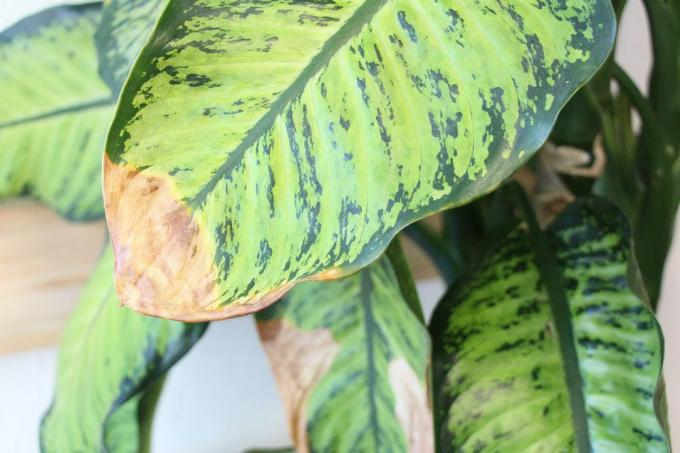
table of contents
- causes
- Water imbalance
- Iron deficiency
- Overfertilization
- Wrong location
- Wrong wintering
No matter whether standing free in the room or hanging on the wall, Houseplants can upgrade any room and at the same time improve the air in the room. They can be very easy to care for but also particularly demanding. Even if all houseplants have the same basic needs, each individual plant species has very specific requirements. There is no generalizing care for all species. Care mistakes happen and can quickly lead to yellow or brown discoloration of the leaves.
causes
Causes leaf discoloration
Brown leaf tips and edges can be an indication of both a lack of water and too much moisture, often in connection with too high or low humidity. If the plants are permanently too dry, the leaves will eventually die. Dry heating air in winter or an outdoor location in summer allows the earth to dry out relatively quickly. If the water is then not poured, this damage caused by drought occurs. Too low humidity can be a problem, especially for some tropical plants. But native houseplants can also suffer from dry air, especially in winter, and are grateful for a shower or two on very warm days.
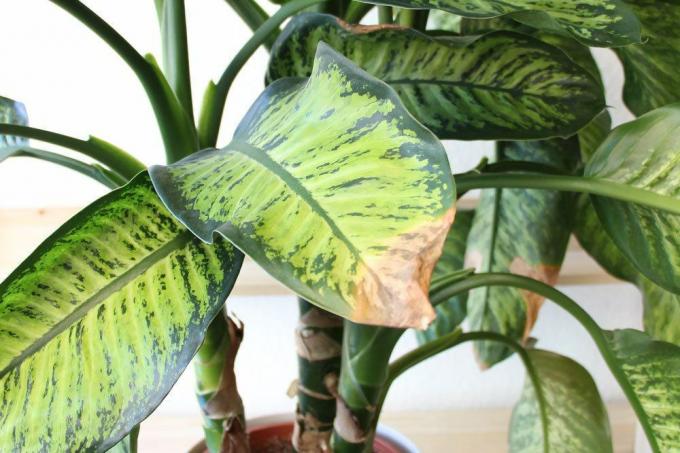
Water imbalance
Lack of water or excess
The leaves of indoor plants can turn yellow or brown and wilt even if they are too wet. Often these symptoms are misinterpreted and used as an opportunity to water more. Of course, that can make the problem worse. If too much moisture is causing the leaves to turn brown or yellow, watering is the worst thing you can do. In most cases, too much moisture is more harmful to indoor plants than a temporary lack of water. The moisture in the soil displaces the soil air. As a result, the roots suffocate and can neither absorb water nor nutrients, they wither. Watering too often, blocked drainage holes or stagnant water in saucers or planters can be responsible for waterlogging.
To remedy the situation
- do not over water the affected plant immediately
- that could more likely damage the plant
- Gradually increase the watering quantity to a sufficient level
- Water more often in warm room temperatures than in cool rooms
- If the leaves are yellow or have brown tips, do not water for the time being due to too much moisture
- Let the substrate dry well
- Only water when the soil is slightly damp on the surface, about thumb depth
- if parts of the root are already rotten, it is better to repot the plant
- remove old soil and rotten roots
- then repot in fresh substrate and a smaller pot
- treat affected plants like cuttings to encourage the formation of new roots
- To do this, put a translucent plastic bag over the plant and the pot
- ventilate the whole thing from time to time
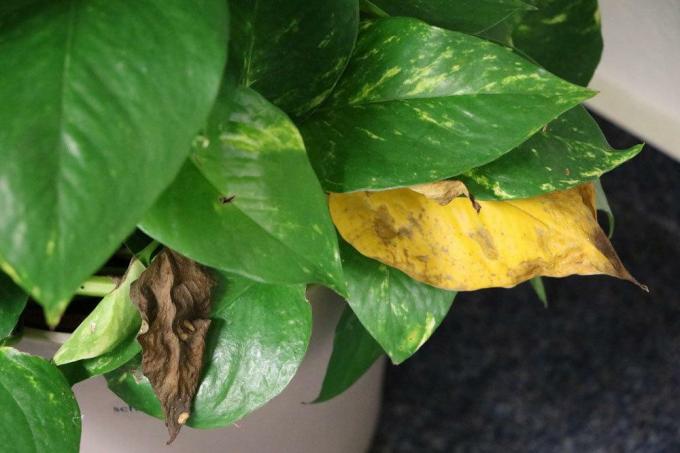
This measure is particularly useful for smaller plants. In addition, coasters and planters should be regularly checked for residual water and, if necessary, emptied. An exception are marsh plants such as Cyprus grass, which should be in the water at all times, as well as cacti, which prefer dry rather than moist. To ensure a higher level of humidity, the plants should be sprayed with water from time to time, preferably with water that is low in lime. There are exceptions here, too, because indoor plants with velvety hairy leaves usually do not like to be sprayed.
Iron deficiency
If the leaves turn yellow, this can also indicate a lack of nutrients, especially an iron deficiency. The most important nutrients are initially abundant in fresh substrate. The plant consumes part of it, but a certain part is also washed out with the irrigation water and is no longer available to the plants.
If replenishment in the form of appropriate fertilizer applications is not provided, deficiency symptoms and these leaf discolorations will occur. Very often calcareous water leads to an increased pH value of the soil and thus to an iron deficiency, especially in acid-loving indoor plants. The lime accumulates in the soil, where it inhibits the growth of the root tips, which in turn prevents the absorption of iron.
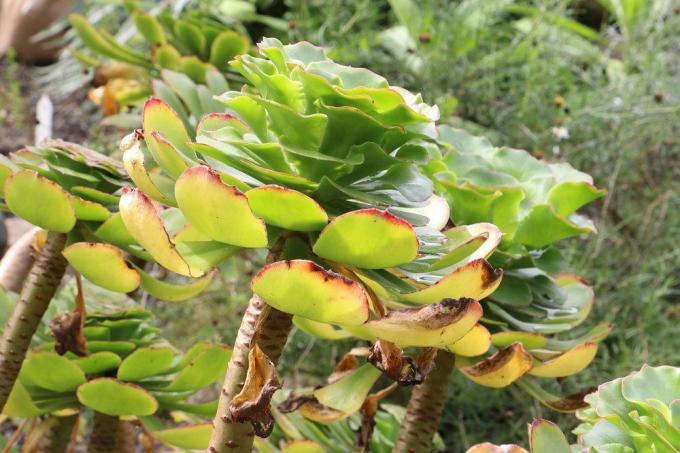
Countermeasures
- Pour with rainwater or softened tap water
- Tap water should be stale for at least two days
- so lime can settle on the ground
- Iron fertilizer helps the plant to regain its strength
- give special iron fertilizer over the irrigation water
- or repot the plant in a loose and acidic substrate
Overfertilization
Too much fertilizer can burn the roots of indoor plants. What follows is a yellow coloration of the leaves, which then dry up and eventually die off. At the first signs of over-fertilization, the houseplant in question should be transplanted into fresh substrate.
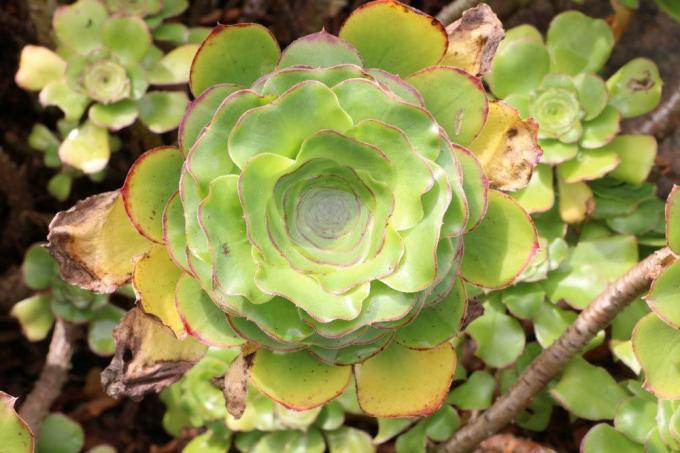
In the case of less sensitive species, you can try to wash some of the fertilizer out of the soil by holding it under running water for a few seconds. After that, watering should be avoided for a few days so that the substrate can dry off. In order to prevent renewed over-fertilization, you should always pay attention to the individual fertilizers Requirements of the respective plant species and the manufacturer's information on the dosage of the respective fertilizer orientate.
Wrong location
Unfavorable site conditions
Brown leaf tips can also be the result of a sudden change of location or a location unsuitable for the plant in question. If the leaf margins turn brown and the water supply is OK, the plant is probably too warm. There are plants e.g. B. Tropical plants that love to stand in the sun in a warm south or west window. Others prefer a warm spot without blazing sun at the north window or rather shady and cool at an east-facing window.

The location in living spaces should be selected accordingly. If the needs of the respective plant are not taken into account, this can quickly lead to such unsightly leaf discoloration. Many indoor plants are also sensitive to drafts or touch, for example if they are in a drafty passage area and you repeatedly brush them as you walk past. They then show their displeasure by the brown tips of their leaves. Even in apartments where people smoke, discoloration of the leaves, leaf margins or leaf tips can often be observed on indoor plants, because polluted air can also be a cause.
To remedy the situation
- based on the conditions of these plants in their natural locations
- this includes the amount of light and precipitation as well as the quality of the soil
- implement this as well as possible in the living room at home
- this can avoid plant damage due to unfavorable site conditions
- In addition, avoid drafts and major temperature fluctuations
Wrong wintering
In the winter months, most of the care errors usually occur, which, in addition to pest infestation, can also cause the leaf discoloration mentioned. The reason for this is, among other things, a significantly reduced light output. For this reason, indoor plants should be placed in the brightest possible place without direct sunlight in winter, even if they are generally considered to be shade-friendly.
While the need for light is high even in winter, the need for water is lower. Depending on the ambient temperature, indoor plants evaporate water from the leaves even in winter. The more leaf mass there is, the more water is evaporated. Consequently, watering must also be carried out in winter, albeit reduced. The cooler the winter is, the less watering has to be done and the drier it should be in the pot. A wet soil is always a cold soil and too low a soil temperature prevents the plants from absorbing nutrients.
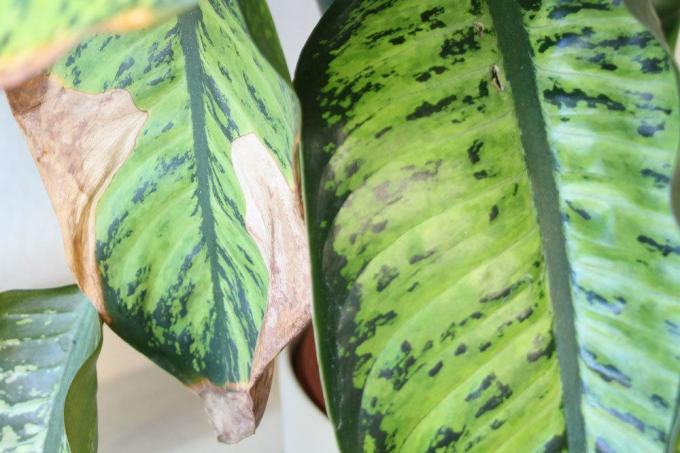
If watering continues as normal, the bale moisture quickly occurs, which quickly leads to rot, especially if it is kept cool during the winter. Plants that are near a heating source need a little more water. Ideally, you water less than the rest of the year and check beforehand whether the soil is still damp. It also does not harm the plants if the substrate temporarily dries out a bit during the resting phase.
Another problem in winter is air that is too dry, which can turn the leaf tips brown. To prevent this, you can occasionally spray the plants with water that is low in lime. To increase the humidity, you can fill a bowl with moist clay granules and place the plants on it. Smaller houseplants can be showered once a month. The substrate should be covered beforehand. Fertilizer should also be used much more sparingly in winter, in some cases it should be completely discontinued.

